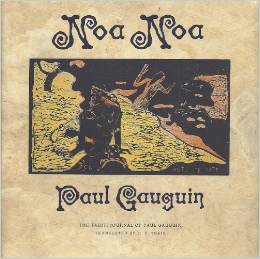 Noa Noa, painter Paul Gauguin’s short book on his time in Tahiti, often gets ignored today. Gauguin, after all, has been chastised for “cutting and running,” leaving a family behind there. Gauguin, who died in 1903, isn’t alive to rebut anything, of course. But he does leave the reader with his sometimes whimsical and at times poignant account of the several years he spent there. And then, of course, there’s his art.
Noa Noa, painter Paul Gauguin’s short book on his time in Tahiti, often gets ignored today. Gauguin, after all, has been chastised for “cutting and running,” leaving a family behind there. Gauguin, who died in 1903, isn’t alive to rebut anything, of course. But he does leave the reader with his sometimes whimsical and at times poignant account of the several years he spent there. And then, of course, there’s his art.
We here at WoWasis read this book when we were young, and it fueled our interest in the tropics. It was worth a revisit. We found a beautiful rendition of it in the book produced by book designer John Miller for Chronicle Books (1994, ISBN 0-8118-0366-X), and that’s the one you should read. There are other versions, some without Gauguin’s art, but art after all, is an essence of the story. Why read the story without he images?
Miller’s version includes colorful sketches drawn by the artist in the margins of his journal, as well as the woodblock prints Gauguin wanted to include, but wasn’t able, in the original publication. For the first time, they’re all included here.
 The story has become legendary, of his disagreements with his first Tahitian wife, of marrying his second when she was thirteen years old. He relates tales from Tahitian mythology that found their way into his paintings. He contrasts the way of life he found in the south Pacific with “the vices of a morally and physically corrupt society” from which he fled.
The story has become legendary, of his disagreements with his first Tahitian wife, of marrying his second when she was thirteen years old. He relates tales from Tahitian mythology that found their way into his paintings. He contrasts the way of life he found in the south Pacific with “the vices of a morally and physically corrupt society” from which he fled.
Radiating through the book are frequent references to the world of exoticism in which he had become imbued in his Polynesian world:
Close to the river Fatu, there was a general scattering. Concealed among the stones the women crouched here and there in the water with their skirts raised to waist, cooling their haunches and legs tired from the march and the heat. Thus cleansed with the bosom erect and with the two shells covering the breasts rising in points under the muslin of the corsage, they again took up the way to Papeete. They had the grace and elasticity of healthy young animals. A mingled perfume, half animal, half vegetable emanated from them; the perfume of their blood and of the gardenias which all wore in their hair. “Teine merahi noa noa (now very fragrant),” they said.
Historical research on the life of Gauguin continues evolving. His death was first reported to be as a result of leprosy, then syphilis. The discovery of teeth purported to be his indicates that he may have died of another cause. He will probably never be released from the cocoon of controversy, if even on a minor scale. We recently visited a friend who had a painting on the wall with a scarf covering part of the image, that of a young woman. It was an original Gauguin, and the owner’s Christian wife had covered the subject’s bare breasts. Too naughty for the household.
Leave a Reply